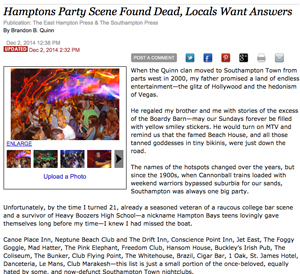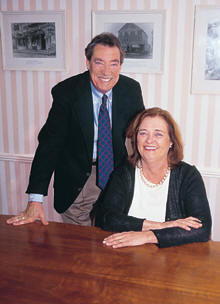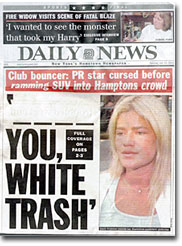Skyrocketing prices, police crackdowns on groupie houses, and the arrival of the Kardashians spelled doom for the "little folk" in the Hamptons.
 "Between the cost of living, lack of entry-level professional jobs and an affordable housing void, the East End has blossomed into a playground for the rich and a gated community for everyone else," wrote Southampton Press reporter Brandon Quinn Dec. 4.
"Between the cost of living, lack of entry-level professional jobs and an affordable housing void, the East End has blossomed into a playground for the rich and a gated community for everyone else," wrote Southampton Press reporter Brandon Quinn Dec. 4.
Quinn's article ran under a headline across the entire page that said, "Hamptons Party Scene FOUND DEAD."
Focusing national attention on the East End of Long Island was the debut Nov. 9 of "Kourtney & Khloe Take the Hamptons," the latest in a series of cities being visited by the Kardashian family. [Fans of the Kardashians can watch the first five episodes on e-online.]
Heavy media coverage has accompanied the arrival of the Kardashians. The New York Post headlined: "Keep Them Out."
Huffington Post headlined: "Nobody Took the Hamptons on the First ‘Kourtney & Khloe Take the Hamptons.'"
PR Firms Thrive in Hamptons
PR, which makes heavy use of celebrities, is well represented in the East End. Nine firms are listed in the "Yellow Pages" for East Hampton although the apparent largest one, Mullen & McCaffrey, founded in 1984, is not on the list.
Principals are John Mullen, former creative executive at Ogilvy & Mather Direct Response, and Mary Ann McCaffrey, former account supervisor at BBDO, Grey Advertising and Wells, Rich, Greene.
M&M has produced TV, radio and direct mail featuring Kathleen Turner, Alec Baldwin, Bill Joel, Dick Cavett, George Plimpton and other celebrities for businesses, non-profits and government agencies. The website gives a "partial" list of 32 current clients including A&P, Bravo, Newsday, CUNY, Southampton Hospital, NYS Dept. of Economic Development and Village of East Hampton.
Other PR firms listed include Word Hampton of E.H.; Kupcha Marketing Services, Bay Shore; Cordes PR South Beach; Communications Strategy Group, Smithtown; A&K Drinkwater PR, Greenport; Bruce Cohen Group, Water Mill; Courtney King PR, Southampton; Hicksville Minute Man Press, and Minuteman Press of Williston Park.
Jody Donohue for many years was one of the leading PR counselors in the East End. However, her car struck and killed social figure Angier Biddle Duke, 79, on April 30, 1995 while he was rollerblading in Southampton. She was not charged in the accident but sold her firm in 1997 to co-workers Joan Diegnan and Linda Mann, becoming a consultant. The only news medium that identified Donohue as the driver was the New York Post. The New York Times, Washington Post, etc., carried extensive obits on Duke and descriptions of the accident but left out the name of the driver.
 Given the penchant of celebrities and the rich for privacy, there are no doubt other PR reps in the East End who don't list themselves publicly. The insistence of the wealthy on privacy was covered in the January 2013 Harper's by writer John P. Davidson who falsely identified himself in order to enroll in the Starkey School for servants.
Given the penchant of celebrities and the rich for privacy, there are no doubt other PR reps in the East End who don't list themselves publicly. The insistence of the wealthy on privacy was covered in the January 2013 Harper's by writer John P. Davidson who falsely identified himself in order to enroll in the Starkey School for servants.
22+ Nightclubs Closed
Quinn listed 22 nightclubs that have closed including Club Marakesh, Westhampton Beach, once the most popular nightclub on Long Island; Conscience Point Inn, where PR counselor Lizzie Grubman at 2 a.m. on July 7, 2001 crashed her Mercedes Benz SUV into a crowd of about 15; Neptune Beach Club, also known as "hotdog beach" for those in their late teens, and The Drift Inn, Danceteria, Le Mans, Tide Runners, Jet east, Mad Hatter, Pink Elephant, Brazil, Buckley's Irish Pub, The Coliseum, The Bunker, Club Flying Point, The Whitehouse, Brazil, Cigar Bar, 1 Oak St., and St. James Hotel.
The list, wrote Quinn "is just a small portion of the once-beloved, equally-hated by some, and now-defunct Southampton Town nightclubs."
The Drift, on Dune Road in East Quogue, was called "the center of the summer scene and everyone loved it," says Quinn. "We all wanted to be there every Saturday."
Grubman, who served 38 days in solitary confinement, had pleaded guilty to certain charges. The incident touched off a tidal wave of criticism of life in the Hamptons led by stories in the New York Post and New York News
 Mullen, McCaffrey |
Quinn does not believe the Grubman incident "killed the Hamptons era of excess." What it did was "turn the lights on," he says.
He credits Grubman with "fighting town attorneys in the media for the right to party" as early as 1999. She represented Conscience Point Inn and Jet East.
She stuck up for the two clubs as "code enforcement officers swarmed in and hit them with a collective $13,0000 in fines for noise and code violations," writes Quinn. Cars parked illegally outside the clubs were towed away. The two clubs were closed three years after Grubman's 2001 accident at Conscience Point.
Quinn sought an interview with Grubman but she declined.
Town Officials, Police Enforce Rules
Town officials and police have been so energetic in enforcing rules about share houses that there are now only five party-related code violations yearly, Town Attorney Tiffany Scarlato told Quinn.
"There has been a shift away from the share house and toward corporate-sponsored, upscale events thrown at residential homes," she said.
Town Supervisor Anna Throne-Holst told Quinn there is no intention to shut down the clubs or bars and if actions against share houses are somehow doing that it is an unintended side effect.
"We want to be an attractive, high-end destination for tourism," she said. High rents have chased singles all the way to Montauk Point (40 miles from W.H.B.) to the Jersey Shore and even Cap Cod, wrote Quinn. Rent for a three-bedroom house with pool in East Hampton for July 2015 is advertised at $16,500. August including Labor Day would be $22,000.
Newsday Reported Police Pay
Newsday reported base pay and total pay of 49 East Hampton police officers ranging from base pay of $142,341 and total pay of $160,977 for Chief Edward Ecker down to base pay of $84,582 and total pay of $98,792 for officer Michael Selz.
Other total pays were Captain Michael Sarlo, $152,623; Lieutenant Francis Mott, $150,915; Detective Lieutenant Christopher Anderson, $149,032; Detective Sgt. Robert Gurney, $145,646, and Lieutenant Thomas Grenci, $145,445.
Total pay of 34 others ranged from $142,039 to $112,613.
Some police work for local residents by providing security at parties, watching homes while they are away, and performing other duties.
Ex-police officers sometimes become elected officials. Conrad Teller, after serving 20 years as police chief of Southampton, then served ten years as police chief of Westhampton Beach after which he served ten years as mayor of W.H.B. until he was defeated this year by Maria Moore.
Post Rapped W.H.B. Police Pay Package
 Grubman in 2001 |
The New York Post rapped the severance package given to W.H.B. police chief Ray Dean when he retired June 30, the day before Moore was elected.
The paper headlined, "Village to give retiring millionaire cop a huge ‘criminal' payout." The story began: "Charge this cop with robbery."
Dean's package includes $402,713 for 15 years' worth (531 days) of unused sick, vacation and personal time. His pension is $142,000 yearly and since he is only 53 this could amount to $284,000 if he lives another 20 years. A former officer in the Southampton Police Dept., he was given a ten-year contract as head of W.H.B. Police in 1999.
His last pay of $226,236, including extras, for supervising a force of 11, is more than New York City Police chief Bill Bratton makes for supervising a force of 34,500 officers, the Post noted. Dean bought a house in Quogue for $1.3M in 2005 and also owns a 32-foot boat, it added.
Jim Kametler, a former W.H.B. cop who served on the Village board from 2004-2010, called the severance package "outrageous" and something that should "never happen in a small village like this."
W.H.B. Groupie Scene Attacked Years Ago
The recent offensive against "share" or "groupie" houses in Southampton and East Hampton is something that took place many years ago in W.H.B. where we have resided six months a year for the past 35 years.
Driving away the singles resulted not only in numerous nightspots and restaurants closing, but three of the five gas stations. The singles had spent plenty of money not only in such places but in the local supermarket. One of the two movie houses in town closed and the second one is currently threatening to close. It is conducting a $100,000 fund-raising drive in a bid to stay open.
The half dozen nightspots that closed in W.H. had provided live music and dancing. Our favorites included Club Marakesh, where a 12-piece orchestra with male and female vocalists performed each Thursday night, and a club that featured banjoes playing music for sing-a-longs. Hundreds of singles would go to weekly dances at Casey's Hall on Montauk Highway. One of the clubs was on the waterfront in adjacent Remsenburg. The closures included a bowling alley which is now an empty lot.
At least a half dozen restaurants closed including Dora's, Johnny Chih's, Crazy Dog, Finn McCool, and Magic's Pub.
Marakash, referred to as the "Studio 54 of the East End," opened in 1976 and lasted until 1996 when a fight involving club patrons resulted in 21-year-old Shane Daniels, who is black, being critically injured, initially causing him to be in a coma.
Daniels had allegedly been clubbed with a steel steering lock by Austin Offen while off-duty New York detective Constantine Chronis held off potential helpers with his gun. Friends of Chronis told W.H. police that they were attacked by 15-20 blacks. Offen got a 10-year prison sentence and Chronis, 4-8 years.
Teller told the New York Daily News that "We've had fights there every Saturday night…there was no doubt in our minds that something serious was going to happen some day."
"Family" Activities Encouraged
Policy of W.H.B. leaders for many years has been to encourage "family" activities. The village square features a live concert every Thursday night during the summer. Full symphony orchestras, jazz bands, small combos and operatic singers perform. An art festival and circus are annual events. More than $2 million has been spent on a new library.
The loss of the singles market created an economic vacuum. Rabbi Marc Schneier founded the Hampton Synagogue in 1990 in Westhampton Beach and has waged a successful six-year campaign to have the village included in an "eruv," a demarcation using telephone poles, lines and markings that allows Orthodox Jews to perform certain tasks on the Sabbath that they could not otherwise perform.
The markings create a "private domain." A 1,685-word essay on what an eruv is was written for Chabad.org by Lorne Rozovsky.
A federal judge in June said W.H.B. had no laws that could block creation of an eruv. The utility PSEG Long Island issued a license on July 8 for lechis to be attached to 27 poles and Verizon issued a license on July 28 for lechis on 18 poles. Lechis are generally black plastic pieces attached to a pole. Wires atop the pole can also be used.
Rabbi Schneier said he hopes the eruv can be expanded to Westhampton itself, a hamlet adjacent to W.H.B., and Quogue, an adjacent village. W.H., slightly bigger than W.H.B., can be seen on this map.
Jewish People Opposed to the Eruv said it would continue to "fight against putting religious symbols on public property." Lawyer Jonathan Sinnreich said, "The battle has just begun. The question of religious symbols on public property has taken on national attention."
JPOE and W.H.B. are appealing the decision by the federal judge. Brian Sokoloff, an attorney representing W.H.B., said, "This case is far from over."


 Brunswick Group handles Endeavor, which has launched a review of strategic alternatives at the sports and entertainment combine as CEO Ari Emanuel believes Wall Street undervalues his company.
Brunswick Group handles Endeavor, which has launched a review of strategic alternatives at the sports and entertainment combine as CEO Ari Emanuel believes Wall Street undervalues his company. MWWPR has been retained by SportBLX to lead communications for the launch of a platform that allows fans and investors to own shares of unique assets in sports.
MWWPR has been retained by SportBLX to lead communications for the launch of a platform that allows fans and investors to own shares of unique assets in sports. DraftKings is betting on Donald Trump-connected Ballard Partners to help it achieve its economic development and regulatory relief goals in Washington. (1 reader comment)
DraftKings is betting on Donald Trump-connected Ballard Partners to help it achieve its economic development and regulatory relief goals in Washington. (1 reader comment) On November 15, “Ford v Ferrari” will roar into theaters, packing a publicity boost for two great global auto brands right on the marquee. Here's a Top Ten list of films in which a brand played a starring role. (1 reader comment)
On November 15, “Ford v Ferrari” will roar into theaters, packing a publicity boost for two great global auto brands right on the marquee. Here's a Top Ten list of films in which a brand played a starring role. (1 reader comment) Steven Spielberg’s Amblin Partners has brought on Dan Berger as executive vice president and head of communications.
Steven Spielberg’s Amblin Partners has brought on Dan Berger as executive vice president and head of communications.


 Have a comment? Send it to
Have a comment? Send it to 
No comments have been submitted for this story yet.